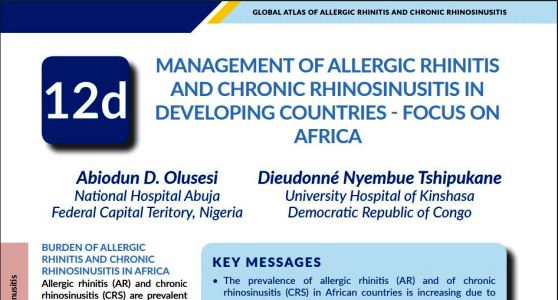
Le Professeur Dieudonné Nyembue du service d’ORL dans le cours des grands.
Avec l’article
MANAGEMENT OF ALLERGIC RHINITIS AND CHRONIC RHINOSINUSITIS IN DEVELOPING COUNTRIES – FOCUS ON AFRICA
Dieudonné Nyembue Tshipukane
University Hospital of Kinshasa Democratic Republic of Congo
BURDEN OF ALLERGIC RHINITIS AND CHRONIC RHINOSINUSITIS IN AFRICA Allergic rhinitis (AR) and chronic rhinosinusitis (CRS) are prevalent non communicable diseases increasing around the world, even in Africa. These chronic diseases confer a significant burden through direct or indirect symptoms, complications and cost. In contrast to developed countries, the government health program of many African countries focus only on transmissible diseases, malnutrition, maternal and infant mortality, while data on respiratory diseases remain scarce. The prevalence of AR is very high (>35%) among Nigerian Africans, and it is likely that environmental factors are responsible for major differences with other countries. AR prevalence is much higher in urban area, especially in capital cities from Africa. CRS is not less common. The advent of HIV-AIDS has further worsened the incidence of CRS in Africa. Local allergens related to African environmental settings are not well known. House dust mites and cockroaches are reported as major allergens in Africa, while pollen allergens remain poorly described. AR predisposes to development of other airway comorbidities such as allergic asthma, rhinosinusitis, nasal polyposis, adenoid hypertrophy and otitis media. Table 1 shows an overview of AR and related diseases in Africa. Both AR and CRS significantly affect the quality of life of Africans through direct cost (payments to doctors for frequent consultations, prescribed medications, over the counter (OTC) drugs, alternative and complementary drugs), indirect costs (loss of work hours and school days) and intangible costs (loss of quality of life, pain and suffering, psychological maladjustment, social costs). These costs become significant in countries with high prevalence of allergy and low per capital income, as seen both in the Anglophone and Francophone African countries.
Management of allergic rhinitis and chronic rhinosinusitis in developing countries – focus on Africa









